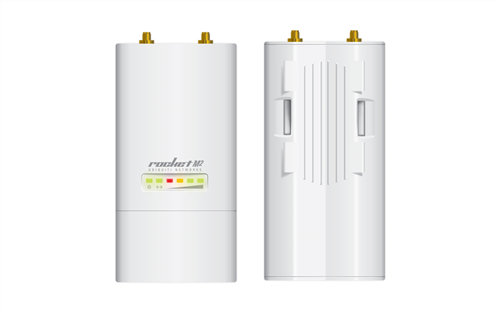 Ubiquiti ROCKETM2 Rocket M2 802.11n/b/g 500mW Outdoor AP/Bridge
Ubiquiti ROCKETM2 Rocket M2 802.11n/b/g 500mW Outdoor AP/Bridge

2.4GHz High Power AirMax Access Point
- 27 dBm Output Power
- airOS 5 Advanced Operating System
- airView and airControl
- airMAX TDMA Technology
- Plug & Play Integration with airMAX
- Frequency and Channel Flexibility
Rocket M2 is a rugged, high-power, very linear 2x2 MIMO radio with enhanced receiver performance. It features incredible range performance and breakthrough speed (150+Mbps real TCP/IP).
Rocket M2 combines the "brains" in one robust unit; it can be paired with your choice of AirMax BaseStation or Rocket Antennas. This versatility gives network architects unparalleled flexibility and convenience.
Compatible Antennas:
Ubiquiti AirMax Sector 2G-16-90
Ubiquiti AirMax Sector 2G-15-120
Ubiquiti AirMax Omni 2G-10
Ubiquiti AirMax Omni 2G-13
Ubiquiti Rocket Dish 2G-26
The RocketM2 2.4 GHz 2x2 MIMO airMAX BaseStation from Ubiquiti Networks features a mix-and-match industrial design, that supports speeds of up to 150+ Mb/s real TCP/IP throughput. It is suitable for deployment in Point-to-Point (PtP) bridging or Point-to-MultiPoint (PtMP) airMAX applications. You have the freedom to locate, deploy, and operate the Rocket in this unlicensed band. Ubiquiti's Time Division Multiple Access (TDMA) airMAX protocol allows each client to send and receive data using pre-designated time slots scheduled by an intelligent AP controller.
The 2.4 GHz frequency band is free to use, however, it is crowded due to interference from other wireless devices. Also, there are only three non-overlapping, 20 MHz channels available for use. The Rocket enclosure is built to survive harsh environments and fits the Rocket mount built into every airMAX antenna. You can pair the rocket with the appropriate antenna for your PtP link or PtMP network.
Plug-and-Play Integration
Rocket radios and airMAX antennas are designed to seamlessly work together. Every airMAX sector, RocketDish, Omni, or Yagi antenna has a built-in rocket mount, so installation requires no special tools. Snap the rockets securely into place and mount the antenna, then you have the optimal combination of Rocket radio and airMAX antenna for your PtP or PtMP application.
airMAX Technology
Ubiquiti's Time Division Multiple Access (TDMA) airMAX protocol allows each client to send and receive data using pre-designated time slots scheduled by an intelligent AP controller. This time slot method eliminates hidden node collisions and maximizes airtime efficiency. It provides significant performance improvements in latency, throughput, and scalability compared to all other outdoor systems in its class.
Intelligent QoS: Priority is given to voice/video for seamless streaming.
Scalability: High capacity and scalability.
Long Distance: Capable of high-speed, carrier-class links.
airOS
Built upon an intuitive user interface foundation, airOS 5 is an advanced operating system for Ubiquiti airMAX product. airOS provides additional advantages, including protocol support, long-range PtP link mode, automatic/manual transmit power control, automatic distance selection (ACK timing), device statistics, and diagnostic tools.
airView
Integrated airView provides advanced spectrum analyzer functionality such as waterfall, waveform, and real-time spectral views that allow operators to identify noise signatures, and plan their networks to minimize noise interference. Waterfall aggregates energy over time for each frequency. Waveform aggregates energy collected. Real-time feature shows energy in real time as a function of frequency. Recording automates airView to record and report results.
airControl
airControl is a powerful and intuitive, Web-based server network management application, which allows operators to centrally manage entire networks of Ubiquiti devices. It features network map, monitor device status, mass firmware upgrade, Web UI access, management of groups of devices, and task-scheduling.



